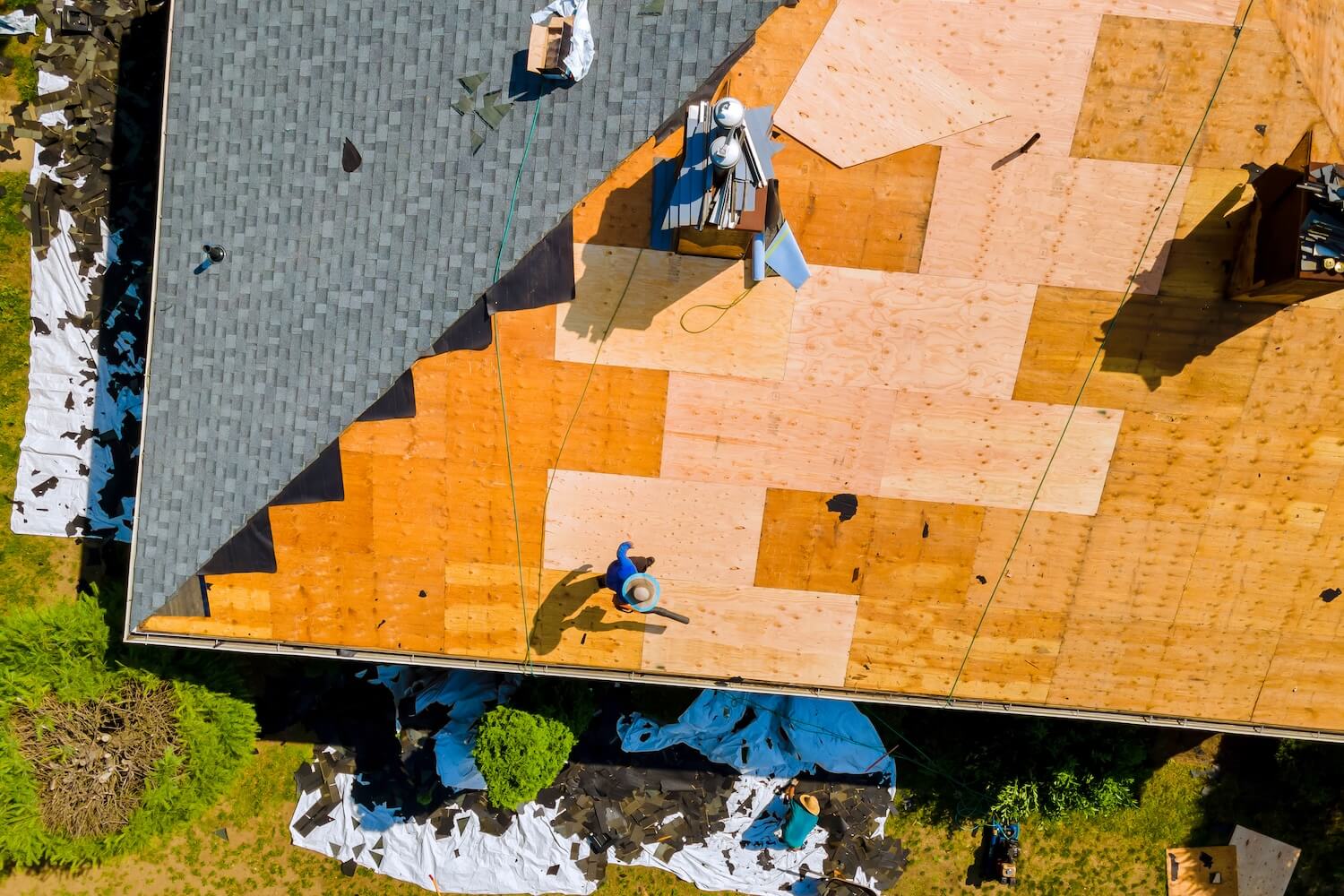A roof replacement is a significant home improvement project that requires careful planning and preparation. Whether you’re replacing a worn-out roof or upgrading to a more durable material, knowing what to expect can make the process smoother and less stressful. This guide will walk you through everything you need to know before the big day, from choosing materials to preparing your home and understanding what happens during installation.

1. Signs It’s Time for a Roof Replacement
Before scheduling a roof replacement, it’s essential to determine if it’s truly necessary. Here are some common signs that indicate your roof needs to be replaced:
- Age of the Roof – Asphalt shingle roofs typically last 20-25 years, while metal and tile roofs can last longer. If your roof is nearing the end of its lifespan, it’s time to consider a replacement.
- Frequent Leaks – Water stains on ceilings, mold growth, or recurring leaks indicate your roof may no longer be effective at keeping out moisture.
- Damaged or Missing Shingles – Shingles that are curling, cracked, or missing altogether can leave your home vulnerable to weather damage.
- Sagging Roof – A sagging or drooping roof can be a sign of structural damage, which requires immediate attention.
- High Energy Bills – If your heating and cooling costs have spiked, your roof may no longer be providing adequate insulation.
2. Choosing the Right Roofing Material
Selecting the best roofing material is crucial for longevity, energy efficiency, and aesthetics. Here are some of the most common options:
- Asphalt Shingles – Affordable and easy to install, asphalt shingles are the most popular roofing material. They come in a variety of styles and colors.
- Metal Roofing – Highly durable and energy-efficient, metal roofs can last 40-70 years and reflect heat, reducing cooling costs.
- Tile Roofing – Clay or concrete tiles offer a unique aesthetic and excellent durability, but they require a strong roof structure to support their weight.
3. Finding the Right Roofing Contractor
Choosing a reliable roofing contractor is key to a successful roof replacement. Here’s how to ensure you hire the best for your project:
1. Do Your Research
It’s essential to do thorough research before hiring a roofing contractor. Begin by asking for recommendations from friends, family, and neighbors who have recently had their roofs replaced. A referral from someone you trust is often a reliable source of information. Additionally, you can use online platforms like Google, Yelp, or Angie’s List to find well-reviewed contractors in your area. Pay close attention to the number of positive reviews and the contractor’s overall rating. Look for feedback specifically about the contractor’s quality of work, professionalism, and punctuality.
2. Check Licensing and Insurance
Verify that the contractor is licensed and insured with both liability insurance and workers’ compensation to protect you from potential damage or injury.
3. Ask for Detailed Estimates
When you receive an estimate, it should be more than just a price quote. A professional contractor will provide a detailed, written estimate that includes the scope of the work, types of materials being used, labor costs, and an estimated timeline for completion. This transparency helps prevent unexpected costs or delays down the line.
4. Research Roof Reputation
Look for a contractor with a solid reputation in your community. Check the Better Business Bureau (BBB) and ensure they have a history of reliable service.
5. Verify References and Portfolio
A trustworthy contractor should be willing to provide references from previous clients. Ask for at least three references, and follow up with them to get an idea of the contractor’s work quality, reliability, and professionalism. It’s also helpful to ask about the contractor’s ability to stick to deadlines, their communication style, and the overall experience during the project.
6. Understand the Warranty
Ensure the contractor provides both material and workmanship warranties. The manufacturer’s warranty typically covers materials for 20-50 years, while workmanship warranties last 1-10 years.
7. Avoid Storm Chasers
Be cautious of contractors who appear after severe weather events. Stick with a reputable contractor who has an established presence in your area.
8. Don’t Be Afraid to Ask Questions
The right contractor will be happy to answer any questions you have about the roofing process. Ask about the installation process, how long it will take, the types of materials they recommend, and what safety measures they will follow during the job.
9. Get Everything in Writing
Before you sign any contract, ensure that all terms are in writing, including the scope of work, project timelines, payment schedules, and any warranties. A written contract protects both you and the contractor by clearly outlining expectations. Avoid contractors who are unwilling to put the agreement in writing or seem vague about key details.
10. Evaluate Communication and Professionalism
Choose a contractor who communicates well and responds promptly. Professionalism and clear communication indicate a smooth project ahead.
4. Preparing Your Home for Roof Replacement
Once you’ve scheduled your roof replacement, take these steps to prepare your home and minimize disruption:
1. Clear the Area Around Your Home
- Move vehicles out of the driveway to prevent damage and provide space for roofing materials and debris removal.
- Remove patio furniture, grills, and potted plants from around the house.
2. Protect Items in Your Attic
- Roofing work can create dust and debris that may fall into your attic. Cover stored items with plastic sheets or drop cloths.
3. Secure Fragile Items Inside Your Home
- Vibrations from hammering and equipment can cause wall decorations, mirrors, and fragile items to shift or fall. Secure or remove them before work begins.
4. Notify Your Neighbors
- Letting your neighbors know about your roof replacement in advance can help them prepare for potential noise and disruptions.
5. Make Arrangements for Pets and Children
- Roof replacements can be noisy and may be stressful for pets and young children. Consider arranging for them to stay elsewhere during the installation.
5. What to Expect on Roof Installation Day
1. Delivery of Materials
- The roofing company will typically deliver materials a day or two before the installation begins. These may be stored in your driveway or yard.
2. Removing the Old Roof
- The first step in the replacement process is tearing off the old roofing material. This can be a loud and messy process, but a professional crew will have a cleanup plan.
3. Inspecting the Roof Decking
- Once the old roofing is removed, the contractor will inspect the underlying roof decking for signs of damage or rot. Any necessary repairs will be made before proceeding.
4. Installing Underlayment and Flashing
- A waterproof underlayment is installed to provide extra protection against moisture. Flashing around chimneys, vents, and valleys is also replaced or repaired.
5. Installing the New Roof
- The new roofing material is installed according to manufacturer guidelines. This step can take anywhere from one to several days, depending on the roof’s size and complexity.
6. Cleanup and Final Inspection
- Professional roofers will clean up debris and use magnetic tools to pick up stray nails. A final inspection ensures that everything is properly installed.
6. Post-Installation Checklist
After the installation is complete, take these steps to ensure everything is in order:
- Inspect the Work – Walk around your home and check for any leftover debris or signs of damage.
- Confirm the Warranty – Make sure you have copies of the manufacturer’s and contractor’s warranties.
- Check for Proper Ventilation – Ensure roof vents are properly installed to prevent moisture buildup.
- Monitor for Leaks – After the first rainfall, check your attic and ceilings for any signs of leaks.
7. Long-Term Roof Maintenance
Proper long-term roof maintenance is essential to keep your roof in top condition and extend its lifespan. Here are key steps to help maintain your roof effectively:
1. Schedule Regular Inspections
Have a professional roofer inspect your roof annually and after storms. Early detection of issues like leaks or damaged shingles can prevent more serious problems and costly repairs.
2. Clean Gutters and Downspouts
Clogged gutters can lead to water damage and leaks. Regularly clean gutters to ensure proper water flow and consider gutter guards to reduce debris buildup.
3. Address Algae, Moss, and Lichen
These growths can trap moisture, leading to roof damage. Remove them promptly and consider copper or zinc strips to prevent future growth.
4. Trim Overhanging Tree Branches
Branches can scrape your roof or fall during storms, causing damage. Keep trees trimmed to prevent these risks.
5. Check for Signs of Wear
Inspecting for cracked, curled, or missing shingles. Address minor damage early to avoid bigger issues. Also, inspect metal components for rust or corrosion.
6. Ensure Proper Ventilation
Proper attic ventilation prevents moisture buildup and extends roof life. Check that vents and exhaust fans are working properly.
7. Address Small Issues Early
Fix small issues, like loose shingles or minor leaks, right away to prevent larger, costlier problems down the road.
8. Keep Roof Valleys and Flashing in Good Condition
Inspect roof valleys and flashing for damage. Poorly maintained valleys can lead to leaks, while damaged flashing needs to be replaced to maintain a watertight seal.
9. Prevent Standing Water
After storms, check for standing water on flat or low-sloped areas. Poor drainage can lead to water damage, so ensure proper runoff.
By staying on top of these maintenance tasks, you can keep your roof in great shape, prevent costly repairs, and maximize its lifespan.
Roof Replacement Conclusion
A roof replacement is a major investment that requires careful planning, but the benefits far outweigh the temporary inconvenience. A new roof not only protects your home from the elements but also improves energy efficiency, enhances curb appeal, and increases property value. By understanding the signs that indicate it’s time for a replacement, selecting the right roofing materials, and hiring a reputable contractor, you can ensure that your home remains safe and secure for years to come.
Investing in a high-quality roof is one of the most important decisions you can make for your home.
While the upfront cost and temporary disruption may seem daunting, the long-term benefits of increased durability, reduced maintenance, and improved insulation make it well worth it. By staying informed, working with skilled professionals, and following proper maintenance practices, you’ll enjoy a beautiful, resilient roof that protects your home and family for decades.










